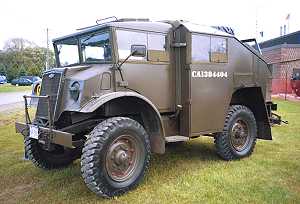 |
A
mostly-restored 1944 Chev Field Artillery Tractor. Belonging to the regimental
association of the 7th Toronto Field Regiment (a militia artillery unit),
this 'Quad' is in superb condition, albeit still needing finishing touches.
The CMP
FAT, together with its limber and 25 pdr gun/howitzer, was the cornerstone
of the divisional Field Regiments, of which there was one per brigade.
These regiments prided themselves on both speed and accuracy in support
of their infantry formations.
For a
superb and exhaustive summary of the role of field artillery in the Canadian
Army Overseas, please see George Blackburn's acclaimed trilogy, "The Guns
of Normandy", "the Guns of Victory" and "Where the Hell Are the Guns?". |
|
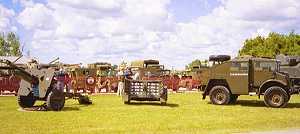 |
The
FAT combination, from right to left, Quad, Limber, Gun. The tractor is
built upon a 101-inch wheelbase chassis, and includes a PTO winch which
could be used to haul from front or rear. |
|
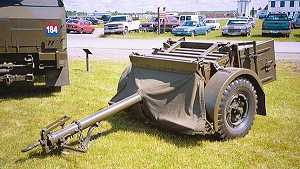 |
The
limber contained a base load of 25 pdr ammunition (32 rounds) which would
be used in 'crash action' drills rather than in normal, emplaced fire.
The Quad towed the limber and the gun was in turn hooked to a pintle on
the back of the limber. |
|
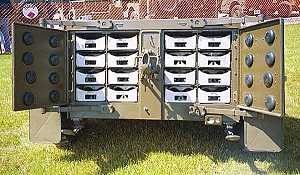 |
The
limber opened up. Each aluminum tray held two rounds. The 25 pdr was made
more flexible by having two-piece ammunition, i.e. a separate case with
adjustable powder charges, and separate projectile. |
|
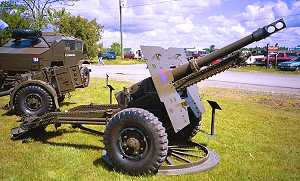 |
The
gun itself. MARINE INDUSTRIES in Sorel, Quebec manufactured 25 pdrs throughout
the war (any others, email me?). Accepted rate of fire was 5 rounds per
minute, but average thoughout the firestorm in Normandy was 12 rpm, with
one documented case in 4th Field of an incredible 17 rounds fired by one
gun in one minute! |
|
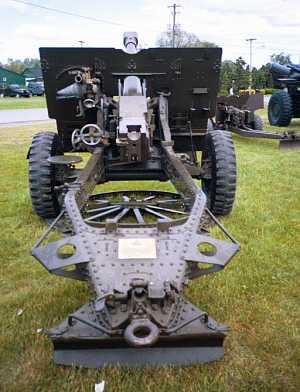 |
View
from the operational end. Note the round plate underneath the wheels. Normally
carried slung under the trails, this device obviated the necessity to dig
in separate trails, and permitted the gun the hitherto unknown luxury of
being able to traverse 360 degrees in seconds. When it was time to change
positionss, the gun was pulled forward off the disk, which was then cranked
up underneath the trail.
Crash
action drills showed that the eight guns of a battery could be brought
into use from column of route in as little as five minutes.
In normal
emplacement, each gun crew would dig a gun pit 18 feet in diameter and
18-36 inches deep. The Quad would then pull the gun into the pit (and winch
it out afterwards). Another pit would be dug by each gun for ammunition
storage.
The survey
method employed by the arty people in Europe ensured that Forward Observation
Officers (FOOs) accompanying the brigade's infantry units could call for
any level of accurate fire from a single gun to every available gun in
theatre, all within a few minutes. The volume of fire of which every 25
pdr regiment alone (24 guns) was capable resulted in several documented
cases where captured German officers had indicated an interest in seeing
our "automatic" field guns. |
|
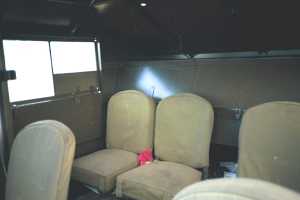 |
The
rear troop compartment of the Field Artillery Tractor, looking from the
left front (gun commander's) seat. The Quad provided transport for a gun
and its crew as an integral unit. There were eight guns per battery, three
batteries per regiment. Troop, battery and regimental personnel rode in
White M3A1 Scout Cars and Heavy Utility Personnel CMPs. FOOs (usually one
per infantry regiment) were assigned Universal Carriers with a driver and
two signalmen. |
|
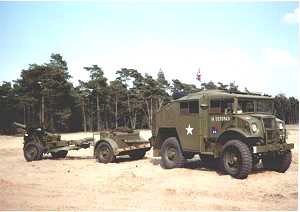 |
Dirk
Leegwater from the Netherlands submits the following two photographs of
a Chev FAT (including limber and gun) in his collection. Truly magnificent! |
|
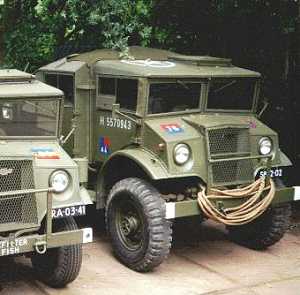 |
Another
view of Dirk's FAT. Well done! |
|
 28 Jan 00
28 Jan 00 |
Back to CMP Softskins |
|
Back to the C60L |
|
Forward to the 15cwt
Truck |
|
| Copyright ©
Geoff
Winnington-Ball , 1999-2000 All Rights Reserved |